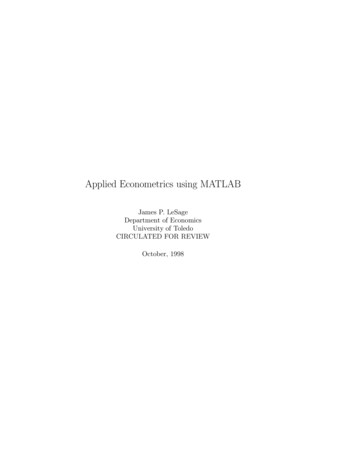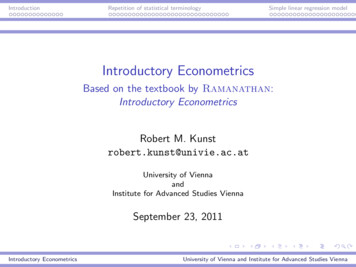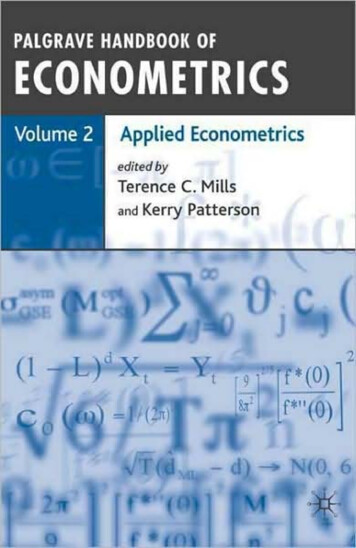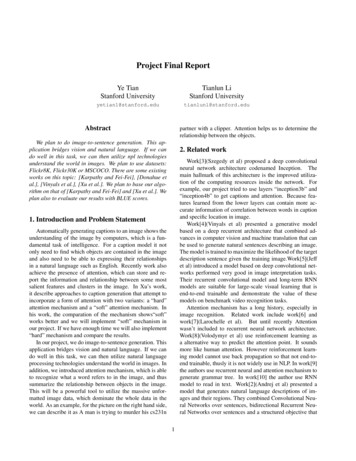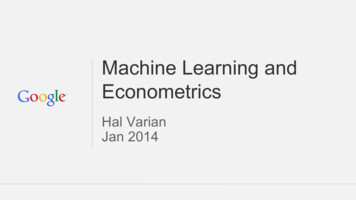
Transcription
Machine Learning andEconometricsHal VarianJan 2014
DefinitionsMachine learning, data mining, predictive analytics, etc. all use data topredict some variable as a function of other variables. May or may not care about insight, importance, patterns May or may not care about inference---how y changes as some xchangesEconometrics: Use statistical methods for prediction, inference, causalmodeling of economic relationships. Hope for some sort of insight, inference is a goal In particular, causal inference is goal for decision makingGoogle Confidential and Proprietary
What econometrics can learn from machine learning“Big Data: New Tricks for Econometrics” train-test-validate to avoid overfittingcross validationnonlinear estimation (trees, forests, SVGs, neural nets, etc)bootstrap, bagging, boostingvariable selection (lasso and friends)model averagingcomputational Bayesian methods (MCMC)tools for manipulating big data (SQL, NoSQL databases)textual analysis (not discussed)Google Confidential and Proprietary
Scope of this talk: what machine learning can learn fromeconometricsI have nothing to say about Computation Modeling physical/biological system (e.g., machine vision, etc.)Focus is entirely on Causal modeling involving human choices Economic, political, sociological, marketing, health, etc.Google Confidential and Proprietary
What machine learning can learn from econometrics non IID data (time series, panel data) [research topic, not in textbooks]causal inference -- response to a treatment [manipulation, intervention] confounding variables natural experiments explicit experiments regression discontinuity difference in differences instrumental variablesNote: good theory available from Judea Pearl et al, but not widely used in MLpractice. The techniques described above are commonly used ineconometrics.Google Confidential and Proprietary
Non IID dataTime series: trends and seasonals are important; cross validation doesn’twork directly; analog is one-step ahead forecasts; spurious correlation is anissue (auto sales); whitening data as a solution: decompose series intotrend seasonal components, look at deviations from expected behavior.Panel data: time effects and individual effects.Example: anomaly detectionSimplest model: yit Fi bxit eitFixed effectsRandom effectsGoogle Confidential and Proprietary
NSA auto sales and Google Correlate to 2012Google Confidential and Proprietary
NSA auto sales and Google Correlate through 2013Google Confidential and Proprietary
Queries on [hangover] and [vodka]Google Confidential and Proprietary
Seasonal decomposition of [hangover]Google Confidential and Proprietary
Does [vodka] predict [hangovers]?Google Confidential and Proprietary
Example of simple transformations for panel datayit Fi bxit eityi Fi bxi eiaverage over time for each individual iyit- yi b (xit - xi) (eit- ei) subtract to get “within estimator”Anomaly detection: look for deviations from typical behavior for eachindividual.Also, panel data is helpful for causal inference as we will see below.Google Confidential and Proprietary
Causality“More police in precincts with higher crime; does that mean that policecause crime?” Policy decision: should we add more police to a givendistrict?“Lots of people die in hospitals, are hospitals bad for your health?”Policy decision: should I go to hospital for treatment?“Advertise more in December, sell more in December.” But what is thecausal impact of ad spending on sales? Policy decision: how much shouldI spend on advertising?Important considerations: counterfactuals, confounding variablesGoogle Confidential and Proprietary
Counterfactuals and causalityCrime. It is likely data was generated by a decision rule that said “addmore police to areas with high crime.” This may have reduced crimeover what it would have been, but these area may still have had highcrime.Hospital. If I go to hospital will be better off than I would have been if Ididn’t go?Advertising. What would my sales be if I would have advertisedless?Google Confidential and Proprietary
Confounding variables 1Confounding variable: unobserved variable that correlates with bothy and x.sales f(advertising) other stuffXmas is a confounding variable butthere are potentially many othersIn this case, the solution is easy: put Christmas (seasonality) in as an additionalpredictor. But there are many other confounding variables that the advertisercan observe that the analyst doesn’t. (E.g., product quality.)Google Confidential and Proprietary
Confounding variables 2Commonly arise when human choice is involved Marketing: advertising choice, price choice Returns to education: IQ, parents’ income, etc. affect both choice ofamount of schooling and adult earnings Health: compliance with prescription directions is correlated withboth medication dosage and health outcomeOmitted variables that are not correlated with x just add noise, butconfounders bias estimatesGoogle Confidential and Proprietary
What do you want to estimate?Causal impact: change in sales associated with change in advertisingexpenditure everything else held constant?orPrediction: Change in sales you would expect to observe whenadvertising expenditure changes ?If you want to make a decision, the former is what is relevant. If youwant to make a prediction the latter is relevant.Google Confidential and Proprietary
Ceteris paribus vs mutatis mutandis Ceteris paribus: causal effect with other things being held constant; partialderivativeMutatis mutandis: correlation effect with other things changing as they will;total derivativePassive observation: If I observe price change of dp, how do I expectquantity sold to change?Explicit manipulation: If I explicitly change price by dp, how do I expectquantity sold to change?“No causation without manipulation” Paul Holland (1986)Google Confidential and Proprietary
Big data doesn’t helpYou can have a great model of the relationship between police andcrime, but won’t answer question of what happens if you intervene andadd more police. Why? Data generating process is different. Observed data generated by a “more crime - more police” rule butnow want to know what happens to crime when you add morepolice When predictors are chosen by someone (as in economicexamples), they will often depend on other omitted confounders.Xmas exampleGoogle Confidential and Proprietary
Estimating a demand functionModel: sales price consumer income other stuffPolicy: if I manipulate price, what happens to sales?Observe: historical data on sales and pricePossible data generating process When times are good (boom) people buy a lot and aren’t price sensitive, somerchants raise prices. When times are bad (recession) people don’t buy much and are price sensitive, somerchants cut prices.Result: high prices associated with high purchases, low prices associated with lowpurchases. Problem: “income” is confounding variable. Solutions: 1) bring “income” intomodel (but what about other confounders?), 2) do a controlled experiment, 3) find anatural experiment (e.g., taxes, supply shocks).Google Confidential and Proprietary
One solutionFind other variables that affect price that are independent ofconfounding variables.sales price consumer income other stuffprice markup x cost [markup is chosen, cost is exogenous]price pre-tax price sales tax [price is chosen, sales tax exogenous]Here changes in cost could be due to weather (coffee), global factors (oil), tech change(chips), etc. Sales tax could vary across time and state. As long as these variables areindependent of the demand-side factors, we should be OK.Variables like this are called instrumental variables since they are an “instrument” thatmoves predictor exogenously, similar to the manipulation you are considering.Google Confidential and Proprietary
What is the intended use of demand estimation?Tell consumers what to expect prices to be in the future? Want to model historical relationship Estimate relationship “mutatis mutandis” Oren Etzioni, et al paper: “To buy or not to buy: mining airfare data tominimize ticket purchase price”Tell managers what will happen if they manipulate price? Want to model causal relationship Ideally, run an experiment Alternatively, find a natural experiment and/or instrument (fuel price?) Estimate relationship “ceteris paribus”Google Confidential and Proprietary
You usually want the causal impact for policyIf you are using data to make decisions, you usually want the causal impact.Examples from: James, Witten, Hastie, Tibshirani, An Introduction to Statistical Learning,2013Marketing“What effect will changing the price of a product have on sales?”Not just an inference problem, but a causal inference problemGenerally there will be confounding variables in such a problemEducationincome education seniority (Mincer equation)For policy (e.g., changing schooling requirements) you want a causal estimateof education effect, but you won’t get that from historical data since people chooseeducation and choice depends on ability, family income, etc.Google Confidential and Proprietary
Practical techniques for causal inferenceNeed some sort of exogenous change in x to estimate causal effect1. Gold standard: true randomized treatment-control experimenta. Google, Bing, Yahoo, Facebook, etc2. Natural experiments which may or may not be randomizeda. Example: draft lottery, Oregon healthcare lottery, etcMay need to model: who gets treated (a prediction problem)Random, volunteers, chosen, invited Question to ask: how does proposed policy relate to experiment?Definitely need to model: counterfactual (prediction problem)What would have happened to the treated if they weren’t treated?Simple: they would look like the control on averageComplex: more elaborate predictive modelGoogle Confidential and Proprietary
Role of counterfactualShould I recuperate from an operation in hospital or home?Lots of people die in hospitals!health(went to hospital) - health(stayed home) looks badBut correct comparison is:health(went to hospital) - health(if they had stayed home)Fundamental equation of causal analysis (Angris & Pischke)health(went to hospital) - health(stayed home) [observed]health(went to hospital) - health(if they had stayed home) [treatment effect] health(if they had stayed home) - health(stayed home)[selection bias]Google Confidential and Proprietary
Fundamental equation in causal modelingobserved difference in outcome average effect of treatment ontreated selection biasRandomization: solves selection bias, so observed difference isaverage effect of treatment on (a random sample of) the population.So observed difference in controlled experiment gives you effect oftreatment on population.But you may be interested in impact of treatment on a subjects chosenfor treatment in some other way (volunteers, selected, etc.)Google Confidential and Proprietary
Better prediction give you better causal inferencePredicting who is selected No problem if treatment random, otherwise an issue Probability selected for treatment observables (test scores) Probability selected for treatment unobservables (personality)Predicting the counterfactual Can you predict outcome before or after treatment? (I.e., thosewho are going to be treated.) Can you predict outcome for those not treated (control)?Both of these problems are prediction problems and can benefit frombetter predictive analyticsGoogle Confidential and Proprietary
ExampleTreatment: advertise moreOutcome: sales?1. Predict company X sales using Google Trends category-level querydata using time-series model2. Compare actual sales to predicted sales prior to treatment3. Compare actual sales during advertising treatment to predictedsales during that period4. Difference is causal effect of advertising“Inferring causal impact using Bayesian structural time-series models”Google Confidential and Proprietary
Observed counterfactual usingTrends dataDifferenceCumulativedifferenceGoogle Confidential and Proprietary
Natural experimentsImpact of police on crimeTerrorism alerts in DC (Klick-Tabarrok)Impact of veteran status on future incomeDraft lottery (Angrist)Impact of education on incomequarter of birth (Angrist-Krueger) [see next slide]Impact of medical care on health outcomesOregon lottery (Finkelstein, et al.)Impact of ad impressions on purchasesSuperbowl (Stephens-Davidowitz et al)Google Confidential and Proprietary
Education by quarter of birth, wage by quarter of birthGoogle Confidential and Proprietary
Regression discontinuity (and kinks)Treatment applied depending on some scoreClass size in Israel (Angrist-Lavy)selection bias: studentsmax class size 40Position effect of adsselection bias: placementad rank bid x ad qualityThresholds show up in lots of policies.and also lots of algorithms (trees)Google Confidential and Proprietary
Examine outcomes for subjects near thresholdsPerhaps can apply regression discontinuity approach in tree models?Difference between subjects slightly above and below thresholds in atree model could be just due to random noise.In fact, we could also explicitly randomize so we are confident it israndom noise. Adding the noise has low expected cost.Google Confidential and Proprietary
Randomization is too important to be left to chance!1. Write code so that you can experimentif(x some parameter) do somethingvsif(x some parameter e) do something2. Can fine tune the parameter3. Once you understand responses you can simulate: “rerun yesterday” withdifferent parameter valuesGoogle Confidential and Proprietary
Experiments are not just for high tech“How big of a change is it that you can now gather so muchinformation about your customers?”It’s powerful. About 50 percent of our transactions occur on our Panera (PNRA) card.So we have individual information on individual purchase activities. That means thatwhen we’re going to do something, we can actually look at its impact on behavior andbuild our marketing and our campaigns around individual consumers or small groupsof consumers as opposed to the mass market. Everybody is going to get something alittle different depending on what their behavior is.Panera Bread CEO Ron ShaichOnce you understand behavioral responses simulation can be usefulGoogle Confidential and Proprietary
Partially baked ideaBuild in experimentation at compile time.Every language has a statement like this:const price 5.0Consider a statement like this:param price 4.00:6.00 inc .50outcome salesCompiler generates code to assign random value to “price” at run timeand keeps track of outcome variables “sales”Can run compiler on existing code, making it more powerfulMake experimentation the path of least resistance.Google Confidential and Proprietary
Partially baked idea, further considerationsparam color (blue, yellow, green)outcome clicks Can run many experiments at once if they don’t interfere Can specify layers that make it easy to avoid interference Not just for computer’s internal environment (ATLAS softwareoptimization tool) , but also on responses in external environment(such as human responses)Google Confidential and Proprietary
Instrumental variablesyi β0 β1 Xi eiProblem: confounding variables that affect both e and XHowever, some part of the variation in Xi may be independent of errorCan we find something that changes X, but does not affect error?Estimate coffee demand elasticity: look at supply shifts due to weatherExamples: demand for cigarettes, cigarette taxes by stateOverall tax rate might be an instrumentInstrument Z has two propertiesZ is highly correlated with X [testable]Z is not correlated with the error [not testable]Z only affects y via the X variableestimate dX/dZ and dY/dZ and then take ratio to get dY/dXGoogle Confidential and Proprietary
Instrumental variablesBest instrument is randomization: use a coin flip to choose XIf it is random, it isn’t correlated with omitted variables (error)But there may exist some variable that affects X and isn’t correlatedwith the error; that is, the instruments affects y only via its effect on X.Elaborate econometric theory to deal with instruments.Google Confidential and Proprietary
Difference in differencesTwo groups: treatment, controlTwo time periods: before and after treatment(Treatment may or may not be randomly TACAafter - before (TA - TB)treatment - control (TA - CA)DiD (TA - TB) - (CA - CB)DiD: impact of treatment ontreated, adjusted by controlGoogle Confidential and Proprietary
Regression interpretationtreati 1 if treated, 0 if controlafteri 1 if after, 0 if beforeβ3 treatment effectyi β0 β1 treati β2 afteri β3 treati*afteri other things that affect y eiTreatmentControlDifferenceBeforeβ0 β1β0β1Afterβ0 β1 β2 β3β0 β2β0 β3Differenceβ2 β3β2β3Google Confidential and Proprietary
How much should you worry about selection bias?Economics Experiment to determine policy change for population Impact of treatment on population Worry about selection bias: want random sampleBusiness Impact on advertisers who choose to use new feature or service Impact of treatment on those who choose to be treated Not necessarily worried about selection bias (but may be worriedabout early adopter bias)Google Confidential and Proprietary
What are lessons?1. Observational data (usually) can’t determine causality, no matterhow “big” it is.2. Causal inference is what you want for decisions3. Treatment-control with random assignment is gold standard4. Sometimes you can find natural experiments, discontinuities,instrumental variables, DiD, etc.5. Prediction is critical to causal inference: predict who is selected,predict counterfactual6. Interesting research possibilities in systems optimized for testingGoogle Confidential and Proprietary
Two very good introductory books to follow upMostly Harmless EconometricsJoshua Angrist and Jörn-Steffen PischkeIntroduction to Statistical LearningGareth James, Daniela Witten, Trevor Hastieand Robert TibshiraniGoogle Confidential and Proprietary
Machine learning, data mining, predictive analytics, etc. all use data to predict some variable as a function of other variables. May or may not care about insight, importance, patterns May or may not care about inference---how y changes as some x changes Econometrics: Use statistical methods for prediction, inference, causal
